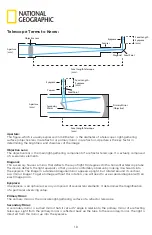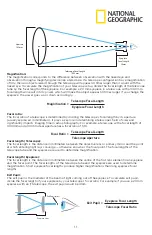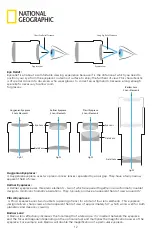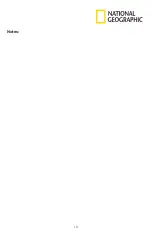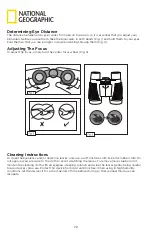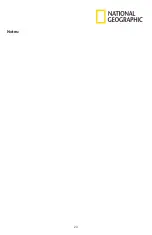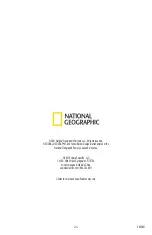
17
How do I observe the specimen?
Sitting in your location with adequate illumination chosen from the colour filter wheel, the following basic
rules should be observed. Start with a simple observation at the lowest magnification.
Place the prepared slide directly under the objective on the microscope stage and secure it with the
stage clips. The prepared slide should be located directly over the lower illumination. Look through
the eyepiece and carefully turn the focus knob until the image appears clear and sharp. Higher levels
of magnification can be achieved by turning the objective turret to a higher setting (400x or 900x).
Following this procedure creates a steady increase of magnification without overpowering the view
of the object. The following magnification order should be used: 100x, 400x then 900x. Each time the
magnification changes (due to the objective change), the image sharpness must be readjusted with
the focus knob. When doing this, be careful because if you move the microscope stage too quickly, the
objective and the slide could come into contact and cause damage to the slide or microscope.
For transparent objects (e.g. sea salt), light is projected by the lower light traveling from below the stage,
through the objective and eyepiece, and finally into your eye. This process of light transmission is known
as microscopy. Many micro-organisms found in water, plant components and the smallest animal parts
are transparent in nature. Opaque specimens, on the other hand, will need to be prepared for viewing.
Opaque specimens can be made transparent by a process of treatment and penetration with the correct
materials (media), or by slicing. You can read more about creating specimens in the enclosed microscope
experiments booklet.
Magnification Guide:
Eyepiece
Objective
Power
20x
5x
100x
20x
20x
400x
20x
45x
900x
Did You Know?
The highest magnification is not always the best for every specimen!
Smart Microscope Slides
This microscope set includes a number of prepared slides designed to jumpstart your investigations.
These Smart Microscope Slides include a QR code on the label that can be used to access additional
information about the particular specimen. With a quick scan of the QR code, you can gain a deeper
understanding of a specimen’s strucutures, functionality and more.
To scan the QR codes, use your phone’s camera and focus on the QR code or download a QR code
reader from your app store and follow your app directions to scan the code with your phone. After
scanning, you will be directed to a website with additional information on the specimen.
To see our full list of smart slides,
scan this code.
Slide example
Peacock
Feather
© National Geographic
Sc
an the QR c
ode
for mor
e inf
ormation.
Synthetic Wool
© National Geographic
Sc
an the QR c
ode
for mor
e inf
ormation.
Pine Leaf
© National Geographic
Sc
an the QR c
ode
for mor
e inf
ormation.
Pine Pollen
© National Geographic
Sc
an the QR c
ode
for mor
e inf
ormation.
Locust Wing
© National Geographic
Sc
an the QR c
ode
for mor
e inf
ormation.
Goldfish Scale
© National Geographic
Sc
an the QR c
ode
for mor
e inf
ormation.
Silk-Natural
Fiber
© National Geographic
Sc
an the QR c
ode
for mor
e inf
ormation.
Rabbit Hair
© National Geographic
Sc
an the QR c
ode
for mor
e inf
ormation.
Honeybee Wing
© National Geographic
Sc
an the QR c
ode
for mor
e inf
ormation.
Dragonfly Wing
© National Geographic
Sc
an the QR c
ode
for mor
e inf
ormation.
Petal
© National Geographic
Sc
an the QR c
ode
for mor
e inf
ormation.
Housefly Leg
© National Geographic
Sc
an the QR c
ode
for mor
e inf
ormation.
Dicotyledon
© National Geographic
Sc
an the QR c
ode
for mor
e inf
ormation.
Onion
Epidermis
© National Geographic
Sc
an the QR c
ode
for mor
e inf
ormation.
Cotton Stem
© National Geographic
Sc
an the QR c
ode
for mor
e inf
ormation.
Silver Berry
Scaly Hair
© National Geographic
Sc
an the QR c
ode
for mor
e inf
ormation.
Bamboo
© National Geographic
Sc
an the QR c
ode
for mor
e inf
ormation.
Feather
© National Geographic
Sc
an the QR c
ode
for mor
e inf
ormation.
Stoma
© National Geographic
Sc
an the QR c
ode
for mor
e inf
ormation.
Dandelion Fluff
© National Geographic
Sc
an the QR c
ode
for mor
e inf
ormation.
Hydrilla
Verticillata
© National Geographic
Sc
an the QR c
ode
for mor
e inf
ormation.








